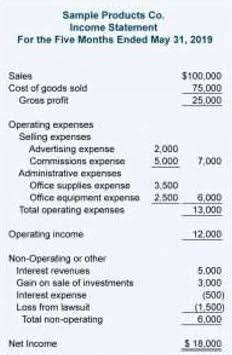
A larger company likely incurs a wider variety of debts while a smaller business has fewer liabilities. What is a liability for one party is an asset for the other – and vice versa. If a company has to pay an invoice to its supplier, this invoice is a liability for the company but an asset for the supplier.
- This funding helps businesses generate cash flow and purchase equipment to speed up their production process.
- Companies of all sizes finance part of their ongoing long-term operations by issuing bonds that are essentially loans from each party that purchases the bonds.
- Liabilities are listed on a company’s balance sheet and expenses are listed on a company’s income statement.
- Liabilities are the duties or obligations due by a partnership to third parties, and they can have an influence on an organisation’s financial situation.
- Liabilities are best described as debts that don’t directly generate revenue, though they share a close relationship.
- Liability is a term in accounting that is used to describe any kind of financial obligation that a business has to pay at the end of an accounting period to a person or a business.
How can analyzing a balance sheet help identify liabilities?
Assets have a market value that can increase and decrease but that value does not impact the loan amount. Liabilities work by representing the claims or obligations an entity has towards external parties. When a company borrows money, for instance, it incurs a liability.
- Refer to Business structures to find out which returns you must file based on the business entity established.
- Although the recognition and reporting of the liabilities comply with different accounting standards, the main principles are close to the IFRS.
- Other line items like accounts payable (AP) and various future liabilities like payroll taxes will be higher current debt obligations for smaller companies.
- Liabilities can help companies organize successful business operations and accelerate value creation.
- Because accounting periods do not always line up with an expense period, many businesses incur expenses but don’t actually pay them until the next period.
Accounting Crash Courses

Accrued expenses are recorded to ensure that the company’s financial statements reflect the accurate financial position. For example, suppose a company’s financial year ends on December 31, and employees have worked in December but will receive their salaries in January. Accrued Expenses are liabilities that arise when a company Bookkeeping for Chiropractors incurs expenses but hasn’t yet made the corresponding payment. These expenses include items like salaries, taxes, utilities, and interest.
Types of liabilities in accounting
You can calculate your total liabilities by adding your short-term and long-term debts. Keep in mind your probable contingent liabilities are a best estimate and make note that the actual number may vary. Expenses are costs incurred in the process of generating revenue, while liabilities are obligations that require future payment.
Impact on Financial Net Worth
But, it’s important to understand that liabilities must get paid. The primary classification of liabilities is according to their due date. The classification is critical to the company’s management of its financial obligations.

How do liabilities influence disposable income?
Interest expenses may accrue on certain liabilities, representing the cost of borrowing. Payments towards liabilities reduce the company’s cash or other assets, impacting its overall financial position. Proper management of liabilities involves assessing repayment capabilities, negotiating favorable terms, and strategically balancing short-term and long-term obligations. Non-current what are liabilities in accounting liabilities can also be referred to as long-term liabilities. They’re any debts or obligations that your business has incurred that are due in over a year. Businesses will take on long-term debt to acquire new capital to purchase capital assets or invest in new capital projects.
- This loan is when a property is used as collateral for obtaining the loan.
- Liabilities are an effective way of getting money and is preferred over raising capital using equity.
- Liabilities in a marketing partnership agreement outline the financial responsibilities each party must fulfill, ensuring clarity and accountability in the partnership.
- It can appear like spending and liabilities are the same thing, but they’re not.
#3 – Contingent Liabilities
These liabilities indicate the company’s obligation to make future lease payments over the lease period. The inverse of deferred revenue is unearned revenue, often known as deferred income. It reflects a company’s obligation when it accepts money for products or services that have yet to be delivered or how is sales tax calculated earned. Companies recognise deferred revenue as a liability until the goods or services are provided. For example, if a software company sells annual subscriptions and receives payment upfront, the amount received is recorded as deferred revenue until the subscription period elapses. Depending on the repayment period, notes payable might be short-term or long-term.

He is a CFA charterholder as well as holding FINRA Series 7, 55 & 63 licenses. He currently researches and teaches economic sociology and the social studies of finance at the Hebrew University in Jerusalem. Generally, you must pay SE tax and file Schedule SE (Form 1040 or 1040-SR) if either of the following applies. Liabilities are primarily categorised based on the priorities they enjoy in terms of being written off the books of a company.
Current Ratio or Working Capital Ratio
Here we show you what types of liabilities there are, how they are financed and why a company should always keep an eye on them. Businesses record liabilities on the company’s balance sheet and record expenses in income statements. These liabilities help businesses acquire capital assets by providing the required capital. Businesses can also invest in new capital projects using the funds obtained from long term debts or liabilities. That said, if the lawsuit isn’t successful, then your business would not have any liability.